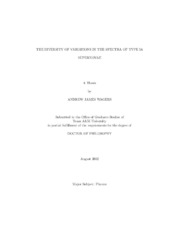| dc.contributor.advisor | Wang, Lifan | |
| dc.creator | Wagers, Andrew James | |
| dc.date.accessioned | 2012-10-19T15:30:05Z | |
| dc.date.accessioned | 2012-10-22T18:00:14Z | |
| dc.date.available | 2014-11-03T19:49:15Z | |
| dc.date.created | 2012-08 | |
| dc.date.issued | 2012-10-19 | |
| dc.date.submitted | August 2012 | |
| dc.identifier.uri | https://hdl.handle.net/1969.1/ETD-TAMU-2012-08-11528 | |
| dc.description.abstract | Type Ia supernovae (SNe Ia) are currently the best probe of the expansion history of the universe. Their usefulness is due chiefly to their uniformity between supernovae (SNe). However, there are some slight variations amongst SNe that have yet to be understood and accounted for. The goal of this work is to uncover relationships between the spectral features and the light curve decline rate, [delta]m₁₅. Wavelet decomposition has been used to develop a new spectral index to measure spectral line strengths independent of the continuum and easily corrected for noise. This new method yields consistent results without the arbitrary uncertainties introduced by current methods and is particularly useful for spectra which do not have a clearly defined continuum. These techniques are applied to SN Ia spectra and correlations are found between the spectral features and light curve decline rate. The wavelet spectral indexes are used to measure the evolution of spectral features which are characterized by 3 or 4 parameters for the most complicated evolution. The three absorption features studied here are associated with sulfur and silicon and all show a transition in strength between 1 to 2 weeks after B-band maximum. Pearson correlation coefficients between spectral features and [delta]m₁₅ are found to be significant within a week of maximum brightness and 3 to 4 weeks post-maximum. These correlations are used to determine the principal components at each epoch among the set of SN spectra in this work. The variation contained in the first principal component (PC1) is found to be greater than 60% to 70% for most epochs and reaching as high as 80% to 90% for epochs with the highest correlations. The same first principal component can be used to relate spectral feature strengths to the decline rate. These relations were used to estimate a SN light curve decline rate from a set of spectra taken over the course of the explosion, from a single spectrum, or from even a single spectral feature. These relationships could be used for future surveys to estimate spectral characteristics from light curve data, such as photometric redshift. | en |
| dc.format.mimetype | application/pdf | |
| dc.language.iso | en_US | |
| dc.subject | Type Ia Supernova | en |
| dc.subject | supernova spectra | en |
| dc.subject | supernova subgroups | en |
| dc.subject | wavelet decomposition | en |
| dc.subject | principal component analysis | en |
| dc.title | The Diversity of Variations in the Spectra of Type Ia Supernovae | en |
| dc.type | Thesis | en |
| thesis.degree.department | Physics and Astronomy | en |
| thesis.degree.discipline | Physics | en |
| thesis.degree.grantor | Texas A&M University | en |
| thesis.degree.name | Doctor of Philosophy | en |
| thesis.degree.level | Doctoral | en |
| dc.contributor.committeeMember | Suntzeff, Nicholas B. | |
| dc.contributor.committeeMember | Kattawar, George W. | |
| dc.contributor.committeeMember | McDeavitt, Sean | |
| dc.type.genre | thesis | en |
| dc.type.material | text | en |
| local.embargo.terms | 2014-10-22 | |


